Kina planlægger nye kulværker, trimmer støtte til ren energi

I denne 27. nov. 2019, Foto, en solpanelinstallation ses i Ruicheng County i det centrale Kinas Shanxi-provins. Mens verdens ledere samles i Madrid for at diskutere, hvordan man kan bremse opvarmningen af planeten, et søgelys falder på Kina, den største udleder af drivhusgasser. Kina brænder omkring halvdelen af det kul, der bruges globalt hvert år. Men det er også det førende marked for solpaneler, vindmøller og elbiler. (AP Photo/Sam McNeil)
Mens verdens ledere samles i Spanien for at diskutere, hvordan man kan bremse opvarmningen af planeten, et søgelys falder på Kina - den største udleder af drivhusgasser.
Kina brænder omkring halvdelen af det kul, der bruges globalt hvert år. Mellem 2000 og 2018, dets årlige kulstofemissioner er næsten tredoblet, og det tegner sig nu for omkring 30% af verdens samlede. Men det er også det førende marked for solpaneler, vindmøller og elbiler, og den fremstiller omkring to tredjedele af solceller installeret på verdensplan.
"Vi er vidne til mange modsætninger i Kinas energiudvikling, " sagde Kevin Tu, en Beijing-baseret fellow med Center for Global Energipolitik ved Columbia University. "Det er det største kulmarked og det største marked for ren energi i verden."
Det tilsyneladende paradoks er muligt på grund af det store omfang af Kinas energibehov.
Men da Kinas økonomi bremser til det laveste niveau i et kvart århundrede - omkring 6% vækst, ifølge regeringens statistikker - de politiske beslutningstagere fordobler deres støtte til kul og andre tunge industrier, den traditionelle rygrad i Kinas energisystem og økonomi. På samme tid, landet reducerer tilskud til vedvarende energi.
På FN's årlige klimatopmøde, i år i Madrid, regeringsrepræsentanter vil lægge sidste hånd på implementeringen af Paris-aftalen fra 2015, som satte et mål om at begrænse den fremtidige opvarmning til 1,5 til 2 grader Celsius over førindustrielt niveau. Nationer kan selv bestemme, hvordan de opnår det.

I denne 28. nov. 2019, Foto, en solpanelinstallation ses i Ruicheng County i det centrale Kinas Shanxi-provins. Mens verdens ledere samles i Madrid for at diskutere, hvordan man kan bremse opvarmningen af planeten, et søgelys falder på Kina, den største udleder af drivhusgasser. Kina brænder omkring halvdelen af det kul, der bruges globalt hvert år. Men det er også det førende marked for solpaneler, vindmøller og elbiler. (AP Photo/Sam McNeil)
Kina havde tidligere forpligtet sig til at flytte sit energimix til 20 % vedvarende energi, herunder atomkraft og vandkraft. Klimaeksperter er generelt enige om, at de oprindelige mål, der blev lovet i Paris, ikke vil være nok til at nå målet, og næste år er nationer forpligtet til at formulere mere ambitiøse mål.
Håbet om, at Kina vil tilbyde at gøre meget mere, svinder.
Nylige medierapporter og satellitbilleder tyder på, at Kina bygger eller planlægger at færdiggøre nye kulkraftværker med en samlet kapacitet på 148 gigawatt - næsten svarende til hele EU's kulkraftkapacitet inden for de næste par år, ifølge en analyse fra Global Energy Monitor, en San Francisco-baseret nonprofitorganisation.
Separat, investeringer i Kinas vedvarende energi faldt næsten 40 procent i første halvdel af 2019 sammenlignet med samme periode sidste år, ifølge Bloomberg New Energy Finance, en forskningsorganisation. Regeringen skåret ned tilskud til solenergi.

I denne 27. nov. 2019, Foto, en solpanelinstallation ses i Ruicheng County i det centrale Kinas Shanxi-provins. Mens verdens ledere samles i Madrid for at diskutere, hvordan man kan bremse opvarmningen af planeten, et søgelys falder på Kina, den største udleder af drivhusgasser. Kina brænder omkring halvdelen af det kul, der bruges globalt hvert år. Men det er også det førende marked for solpaneler, vindmøller og elbiler. (AP Photo/Sam McNeil)
Sidste uge i Beijing, Kinas viceminister for økologi og miljø fortalte journalister, at ikke-fossile brændstofkilder allerede tegner sig for 14,3% af landets energimix. Han indikerede ikke, at Kina snart ville omfavne strengere mål.
"Vi står stadig over for udfordringer med at udvikle vores økonomi, at forbedre folks levebrød, " sagde Zhao Yingmin.
Kina er på skift castet som verdens værste klimaskurk eller dets potentielle ren-energi-frelser, men begge superlativer er noget malplacerede.
Som en hurtigt voksende økonomi, det var altid uundgåeligt, at Kinas energibehov ville stige stejlt. Det eneste spørgsmål var, om landet kunne forsyne en tilstrækkelig stor del af sin økonomi med vedvarende energi til at bremse emissionsvæksten.
Mange iagttagere tog håb fra et kort dyk i Kinas kulstofemissioner mellem 2014 og 2016, samt den kinesiske leder Xi Jinpings udtalelse i 2017 om, at Kina havde "taget en førersæde i internationalt samarbejde for at reagere på klimaændringer."

I denne 28. nov. 2019, Foto, en solpanelinstallation ses i Ruicheng County i det centrale Kinas Shanxi-provins. Mens verdens ledere samles i Madrid for at diskutere, hvordan man kan bremse opvarmningen af planeten, et søgelys falder på Kina, den største udleder af drivhusgasser. Kina brænder omkring halvdelen af det kul, der bruges globalt hvert år. Men det er også det førende marked for solpaneler, vindmøller og elbiler. (AP Photo/Sam McNeil)
I dag kommer landets fornyede fokus på kul som en skuffelse.
"Nu er der en følelse af, at snarere end at være en leder, Kina er det, der er ude af trit, " sagde Lauri Myllyvirta, ledende analytiker ved Center for Research on Energy and Clean Air i Helsinki. Han bemærker, at flere udviklede lande - inklusive Tyskland, Sydkorea og USA - reducerer hurtigt deres afhængighed af kulkraft.
Fossile brændstoffer som kul, benzin og naturgas frigiver kuldioxid til atmosfæren, at fange varme og ændre klimaet. Kul er den største synder.
Sidste år, kulforbruget i USA nåede det laveste niveau i næsten 40 år, ifølge U.S. Energy Information Administration.
Et sted at overveje stigningen, pause og stige igen af Kinas kulsektor er Shanxi-provinsen - en stor bjergregion i det centrale Kina.
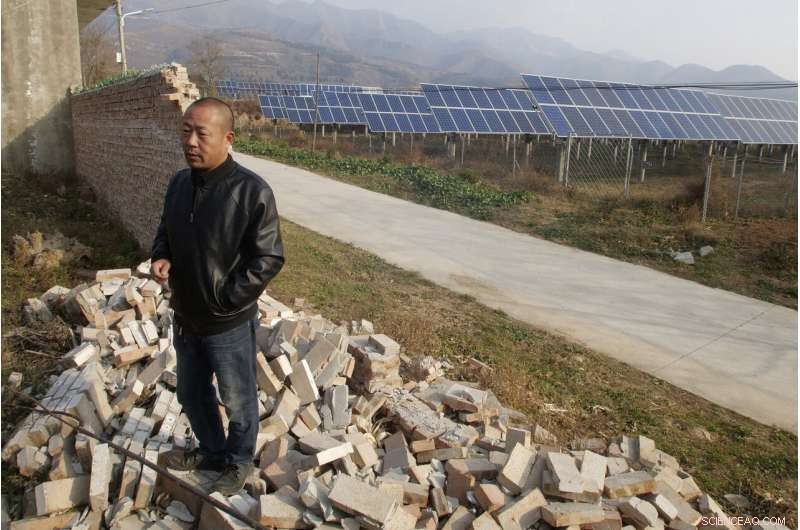
I denne 28. nov. 2019, Foto, Chan Shicun, en byggematerialehandler, points to a wall he said local authorities destroyed after a disagreement with a massive government-backed solar project in Ruicheng County in central China's Shanxi Province. As world leaders gather in Madrid to discuss how to slow the warming of the planet, a spotlight is falling on China, the top emitter of greenhouse gases. China burns about half the coal used globally each year. Yet it's also the leading market for solar panels, wind turbines and electric vehicles. (AP Photo/Sam McNeil)
Shanxi is the heart of China's traditional coal country, dotted with large mines, but also the site of some of the country's largest solar and wind-power projects, according to state media.
During most of the past 30 years of rapid economic growth, the coal business boomed in Shanxi and nearby provinces. As China's cities and industries expanded, coal supplied much of that power, and China surpassed the U.S. as the world's top carbon emitter in 2006.
But after climbing sharply for two decades, China's emissions stalled around 2013 and then declined slightly in 2015 and 2016, according to Global Carbon Budget, which tracks emissions worldwide. This dip came as Chinese leaders declared a "war on pollution" and suspended the construction of dozens of planned coal power plants, including some in Shanxi.
På samme tid, the government required many existing coal operators to install new equipment in smokestacks to remove sulfur dioxide, nitrous oxide and other hazardous substances. About 80% of coal plants now have scrubbers, said Alvin Lin, Beijing-based China climate and energy policy director for the Natural Resources Defense Council, a nonprofit.
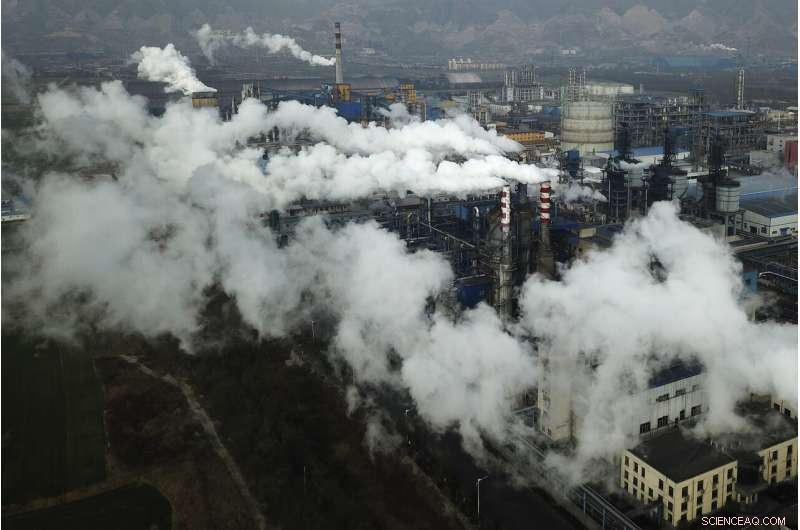
In this Nov. 28, 2019, Foto, smoke and steam rise from a coal processing plant that produces carbon black, an ingredient in steel manufacturing, in Hejin in central China's Shanxi Province. As world leaders gather in Madrid to discuss how to slow the warming of the planet, a spotlight is falling on China, the top emitter of greenhouse gases. China burns about half the coal used globally each year. Yet it's also the leading market for solar panels, wind turbines and electric vehicles. (AP Photo/Sam McNeil)
Som resultat, the air quality in many Chinese cities, including Beijing, improved significantly between 2013 and 2017. Residents long accustomed to wearing face masks and running home air-filter machines enjoyed a reprieve of more "blue sky days, " as low-pollution days are known in China.
Annual levels of PM 2.5—a tiny but dangerous pollutant—dropped by roughly a third across China between 2013 and 2017, from 61.8 to 42 micrograms per cubic meter, according to scientists at Beijing's Tsinghua University and other institutions. They made the report in November in the Proceedings of the National Academy of Sciences , a peer-reviewed journal.
"That's a big improvement, although in terms of safe air quality, we're still not there yet, " Lin said. China's pollution levels are still well above standards set by the World Health Organization.
While these retrofitted coal plants emit fewer pollutants that harm human health, the scrubbers do not reduce greenhouse gases. "The new plants are good for air quality, but you still have all that carbon dioxide that goes into the atmosphere, " Lin said.

In this Nov. 28, 2019, Foto, a coal storage facility is seen in Hejin in central China's Shanxi Province. As world leaders gather in Madrid to discuss how to slow the warming of the planet, a spotlight is falling on China, the top emitter of greenhouse gases. China burns about half the coal used globally each year. Yet it's also the leading market for solar panels, wind turbines and electric vehicles. (AP Photo/Sam McNeil)
In the past three years, China's carbon emissions have begun to rise again, according to Global Carbon Budget.
That trend was evident in the first half of 2019, when China's carbon emissions from fossil fuels and concrete production rose 4%, compared with the same period last year, according to Myllyvirta's preliminary analysis of Chinese government data.
The coming winter in Beijing may see a return of prolonged smog, as authorities loosen environmental controls on heavy industry—in part to compensate for other slowing sectors in the economy. Cement and steel production remain both energy intensive and heavily polluting.
Permits for new coal plants proliferated after regulatory authority was briefly devolved from Beijing to provincial governments, which see construction projects and coal operations as boosts to local economies and tax bases, said Ted Nace, executive director of Global Energy Monitor.

In this Nov. 28, 2019, Foto, a solar panel installation is seen in Ruicheng County in central China's Shanxi Province. As world leaders gather in Madrid to discuss how to slow the warming of the planet, a spotlight is falling on China, the top emitter of greenhouse gases. China burns about half the coal used globally each year. Yet it's also the leading market for solar panels, wind turbines and electric vehicles. (AP Photo/Sam McNeil)
"It's as though a boa constructor swallowed a giraffe, and now we're watching that bulge move through the system, " said Nace. In China, it takes about three years to build a coal plant.
I november, Premier Li Keqiang gave a speech to policymakers emphasizing the importance of domestic coal to energy security.
But because China's coal-power expansion is growing faster than energy demand, overcapacity "is a serious concern now, " said Columbia University's Tu.
And once new infrastructure is built, it's hard to ignore.
"It will be politically difficult to tear down a brand-new coal plant that's employing people and supporting a mining operation. It will make it more difficult for China to transition away from coal, " Nace said.
The world has already warmed by 1 degree Celsius. All scenarios envisioned by the Intergovernmental Panel on Climate Change for holding planetary warming to around 1.5 degrees Celsius involve steep worldwide reductions in coal-power generation.
-
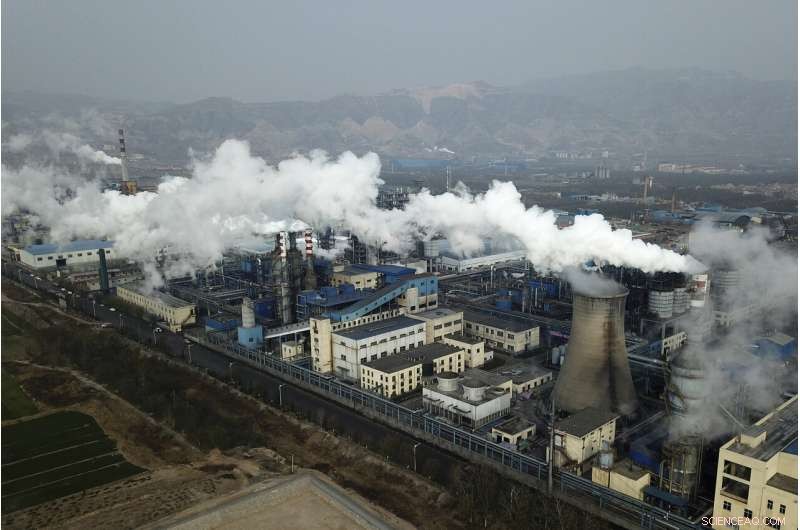
In this Nov. 28, 2019, Foto, smoke and steam rise from a coal processing plant that produces carbon black, an ingredient in steel manufacturing, in Hejin in central China's Shanxi Province. As world leaders gather in Madrid to discuss how to slow the warming of the planet, a spotlight is falling on China, the top emitter of greenhouse gases. China burns about half the coal used globally each year. Yet it's also the leading market for solar panels, wind turbines and electric vehicles. (AP Photo/Sam McNeil)
-
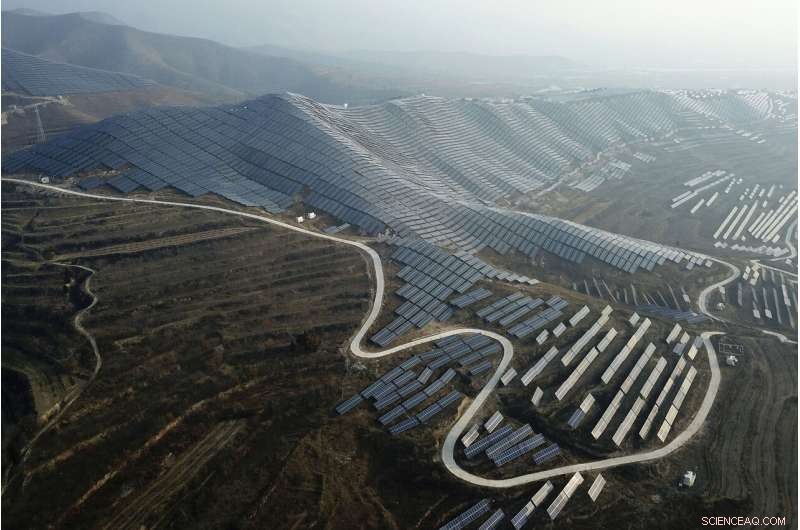
In this Nov. 28, 2019, Foto, a solar panel installation is seen in Ruicheng County in central China's Shanxi Province. As world leaders gather in Madrid to discuss how to slow the warming of the planet, a spotlight is falling on China, the top emitter of greenhouse gases. China burns about half the coal used globally each year. Yet it's also the leading market for solar panels, wind turbines and electric vehicles. (AP Photo/Sam McNeil)
-
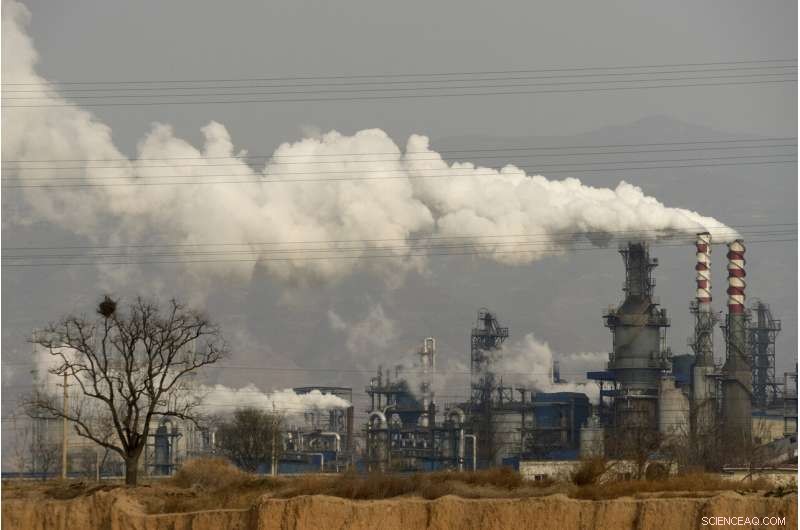
In this Nov. 28, 2019, Foto, smoke and steam rise from a coal processing plant that produces carbon black, an ingredient in steel manufacturing, in Hejin in central China's Shanxi Province. As world leaders gather in Madrid to discuss how to slow the warming of the planet, a spotlight is falling on China, the top emitter of greenhouse gases. China burns about half the coal used globally each year. Yet it's also the leading market for solar panels, wind turbines and electric vehicles. (AP Photo/Olivia Zhang)
In that effort, other countries rely on China to manufacture most of the solar panels installed worldwide, according to an analysis in the journal Videnskab co-authored by Jonas Nahm, an energy expert at Johns Hopkins University.
"If we have any chance to meet climate targets, we have to do a lot by 2030—and we won't be able to do it without China's clean-energy supply chain, " Nahm said.
China's manufacturing helped bring down the cost of solar panels by 80% between 2008 and 2013. Prices for wind turbines and lithium-ion batteries also dropped significantly, according to Bloomberg New Energy Finance.
"China has a really mixed record. On the one hand, it's seen rapidly rising emissions over the past two decades, " Nahm said. "On the other hand, it's shown it's able to innovate around manufacturing—and make new energy technologies available at scale, faster and cheaper."
© 2019 The Associated Press. Alle rettigheder forbeholdes.
Sidste artikelMarsvin kalve udsat for neurotoksiske PCB i modermælk
Næste artikelForskere kappes for at dokumentere Puerto Ricos kystarv
 Varme artikler
Varme artikler
-
 Forskere bidrager til en stor ny rapport om klimaændringernes indvirkning på britiske kyster og ha…Kredit:CC0 Public Domain Universitetsforskere har bidraget til en større ny publikation fra Marine Climate Change Impacts Partnership (MCCIP), der fremhæver de nuværende og fremtidige virkninger a
Forskere bidrager til en stor ny rapport om klimaændringernes indvirkning på britiske kyster og ha…Kredit:CC0 Public Domain Universitetsforskere har bidraget til en større ny publikation fra Marine Climate Change Impacts Partnership (MCCIP), der fremhæver de nuværende og fremtidige virkninger a -
 Hvor hurtigt planeten opvarmes vil være afgørende for levedygtighedenI et forbigående klima, hvor verden hurtigt opvarmes, landområder er varmere og havområder køligere end i et stabiliseret klima. Disse to figurer viser mønsteret af temperaturforskel mellem et forbigå
Hvor hurtigt planeten opvarmes vil være afgørende for levedygtighedenI et forbigående klima, hvor verden hurtigt opvarmes, landområder er varmere og havområder køligere end i et stabiliseret klima. Disse to figurer viser mønsteret af temperaturforskel mellem et forbigå -
 Reproduktion af planter og dyrAlle planter og dyr overalt i verden formerer sig på en eller anden måde som en måde at bringe nye generationer ind og langsomt indlede ændringer i arten. Nogle former for copulation synes at svare
Reproduktion af planter og dyrAlle planter og dyr overalt i verden formerer sig på en eller anden måde som en måde at bringe nye generationer ind og langsomt indlede ændringer i arten. Nogle former for copulation synes at svare -
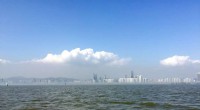 Kontrol med menneskeskabte emissioner kan forbedre vandkvaliteten i kystnære haveMenneskeskabt forurening kan observeres i atmosfæren i mange kinesiske kystbyer, i denne undersøgelse undersøgte forskere den potentielle indvirkning af denne forurening på vandkvaliteten. Kredit:Dr T
Kontrol med menneskeskabte emissioner kan forbedre vandkvaliteten i kystnære haveMenneskeskabt forurening kan observeres i atmosfæren i mange kinesiske kystbyer, i denne undersøgelse undersøgte forskere den potentielle indvirkning af denne forurening på vandkvaliteten. Kredit:Dr T
- Skovjord, der kommer sig efter virkningerne af sur regn
- Ny metode opvarmer ultralydstilgang til behandling af tumorer
- Hvad er de purine baser af DNA?
- Hvordan kan en stregkode redde dit liv?
- En uventet gråzone kunne give langtidsholdbare solceller
- Forskere rapporterer højtydende solid-state natrium-ion batteri


